ACCT20074: Conceptual Framework Application in NAB & Nedbank Analysis
VerifiedAdded on 2023/04/04
|19
|3590
|358
Report
AI Summary
This report provides a financial analysis of National Aust. Bank (NAB) and Nedbank Group Ltd., focusing on the application of the conceptual framework in financial reporting. Part A reviews the history and development of the conceptual framework in the USA, UK, Australia, and globally under the IASB, discussing the Australian accounting profession's concerns and academic perspectives on its quality, benefits, and limitations. It examines how NAB applies the framework, including prepared statements/reports, recognition principles, measurement bases for revenue, assets, and liabilities, and qualitative characteristics of information. Part B contrasts global integrated reporting systems with sustainable reporting rules, analyzing the strengths and limitations of financial accounting rules based on the conceptual framework, comparing Nedbank Group Ltd.'s integrated report against NAB's.
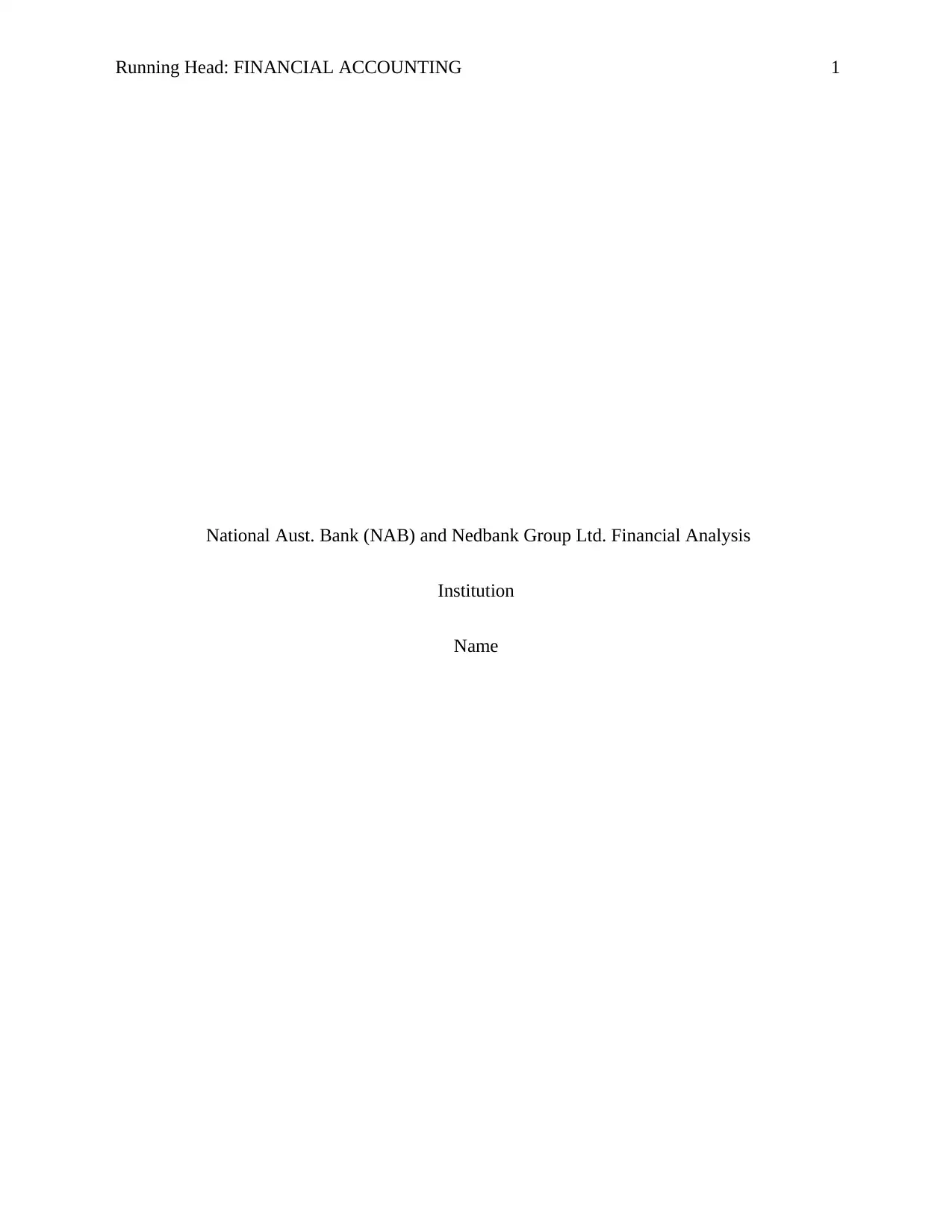
Running Head: FINANCIAL ACCOUNTING 1
National Aust. Bank (NAB) and Nedbank Group Ltd. Financial Analysis
Institution
Name
National Aust. Bank (NAB) and Nedbank Group Ltd. Financial Analysis
Institution
Name
Paraphrase This Document
Need a fresh take? Get an instant paraphrase of this document with our AI Paraphraser
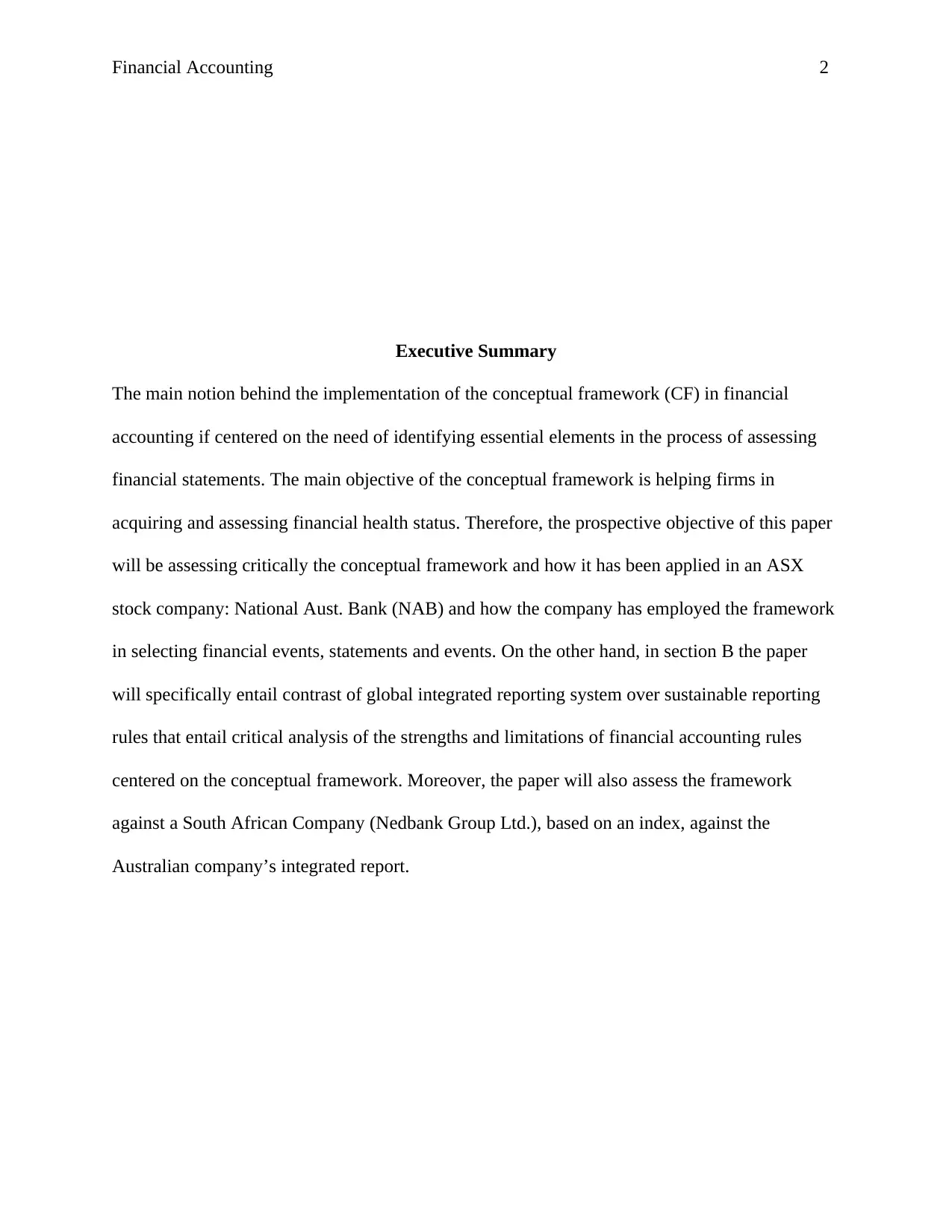
Financial Accounting 2
Executive Summary
The main notion behind the implementation of the conceptual framework (CF) in financial
accounting if centered on the need of identifying essential elements in the process of assessing
financial statements. The main objective of the conceptual framework is helping firms in
acquiring and assessing financial health status. Therefore, the prospective objective of this paper
will be assessing critically the conceptual framework and how it has been applied in an ASX
stock company: National Aust. Bank (NAB) and how the company has employed the framework
in selecting financial events, statements and events. On the other hand, in section B the paper
will specifically entail contrast of global integrated reporting system over sustainable reporting
rules that entail critical analysis of the strengths and limitations of financial accounting rules
centered on the conceptual framework. Moreover, the paper will also assess the framework
against a South African Company (Nedbank Group Ltd.), based on an index, against the
Australian company’s integrated report.
Executive Summary
The main notion behind the implementation of the conceptual framework (CF) in financial
accounting if centered on the need of identifying essential elements in the process of assessing
financial statements. The main objective of the conceptual framework is helping firms in
acquiring and assessing financial health status. Therefore, the prospective objective of this paper
will be assessing critically the conceptual framework and how it has been applied in an ASX
stock company: National Aust. Bank (NAB) and how the company has employed the framework
in selecting financial events, statements and events. On the other hand, in section B the paper
will specifically entail contrast of global integrated reporting system over sustainable reporting
rules that entail critical analysis of the strengths and limitations of financial accounting rules
centered on the conceptual framework. Moreover, the paper will also assess the framework
against a South African Company (Nedbank Group Ltd.), based on an index, against the
Australian company’s integrated report.
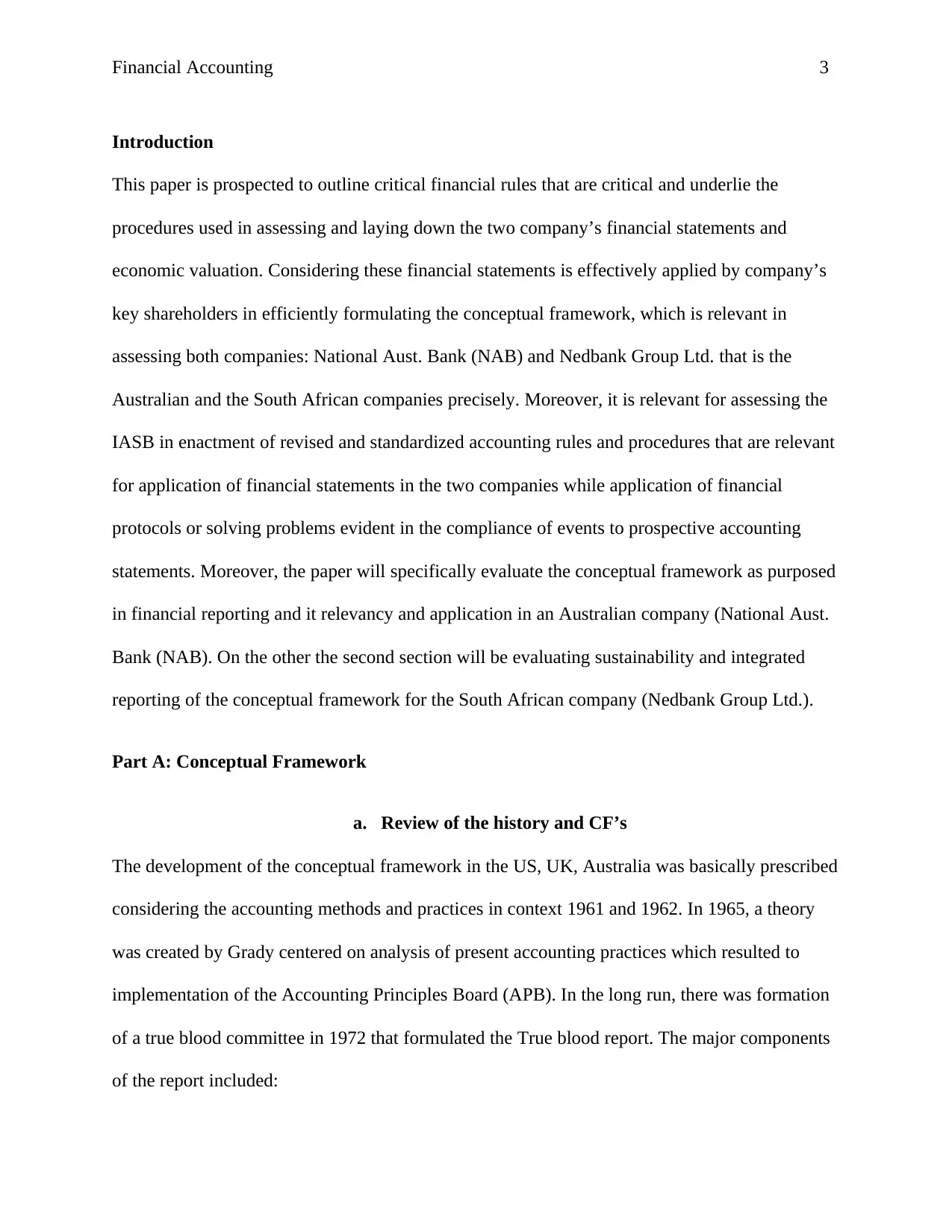
Financial Accounting 3
Introduction
This paper is prospected to outline critical financial rules that are critical and underlie the
procedures used in assessing and laying down the two company’s financial statements and
economic valuation. Considering these financial statements is effectively applied by company’s
key shareholders in efficiently formulating the conceptual framework, which is relevant in
assessing both companies: National Aust. Bank (NAB) and Nedbank Group Ltd. that is the
Australian and the South African companies precisely. Moreover, it is relevant for assessing the
IASB in enactment of revised and standardized accounting rules and procedures that are relevant
for application of financial statements in the two companies while application of financial
protocols or solving problems evident in the compliance of events to prospective accounting
statements. Moreover, the paper will specifically evaluate the conceptual framework as purposed
in financial reporting and it relevancy and application in an Australian company (National Aust.
Bank (NAB). On the other the second section will be evaluating sustainability and integrated
reporting of the conceptual framework for the South African company (Nedbank Group Ltd.).
Part A: Conceptual Framework
a. Review of the history and CF’s
The development of the conceptual framework in the US, UK, Australia was basically prescribed
considering the accounting methods and practices in context 1961 and 1962. In 1965, a theory
was created by Grady centered on analysis of present accounting practices which resulted to
implementation of the Accounting Principles Board (APB). In the long run, there was formation
of a true blood committee in 1972 that formulated the True blood report. The major components
of the report included:
Introduction
This paper is prospected to outline critical financial rules that are critical and underlie the
procedures used in assessing and laying down the two company’s financial statements and
economic valuation. Considering these financial statements is effectively applied by company’s
key shareholders in efficiently formulating the conceptual framework, which is relevant in
assessing both companies: National Aust. Bank (NAB) and Nedbank Group Ltd. that is the
Australian and the South African companies precisely. Moreover, it is relevant for assessing the
IASB in enactment of revised and standardized accounting rules and procedures that are relevant
for application of financial statements in the two companies while application of financial
protocols or solving problems evident in the compliance of events to prospective accounting
statements. Moreover, the paper will specifically evaluate the conceptual framework as purposed
in financial reporting and it relevancy and application in an Australian company (National Aust.
Bank (NAB). On the other the second section will be evaluating sustainability and integrated
reporting of the conceptual framework for the South African company (Nedbank Group Ltd.).
Part A: Conceptual Framework
a. Review of the history and CF’s
The development of the conceptual framework in the US, UK, Australia was basically prescribed
considering the accounting methods and practices in context 1961 and 1962. In 1965, a theory
was created by Grady centered on analysis of present accounting practices which resulted to
implementation of the Accounting Principles Board (APB). In the long run, there was formation
of a true blood committee in 1972 that formulated the True blood report. The major components
of the report included:
⊘ This is a preview!⊘
Do you want full access?
Subscribe today to unlock all pages.

Trusted by 1+ million students worldwide
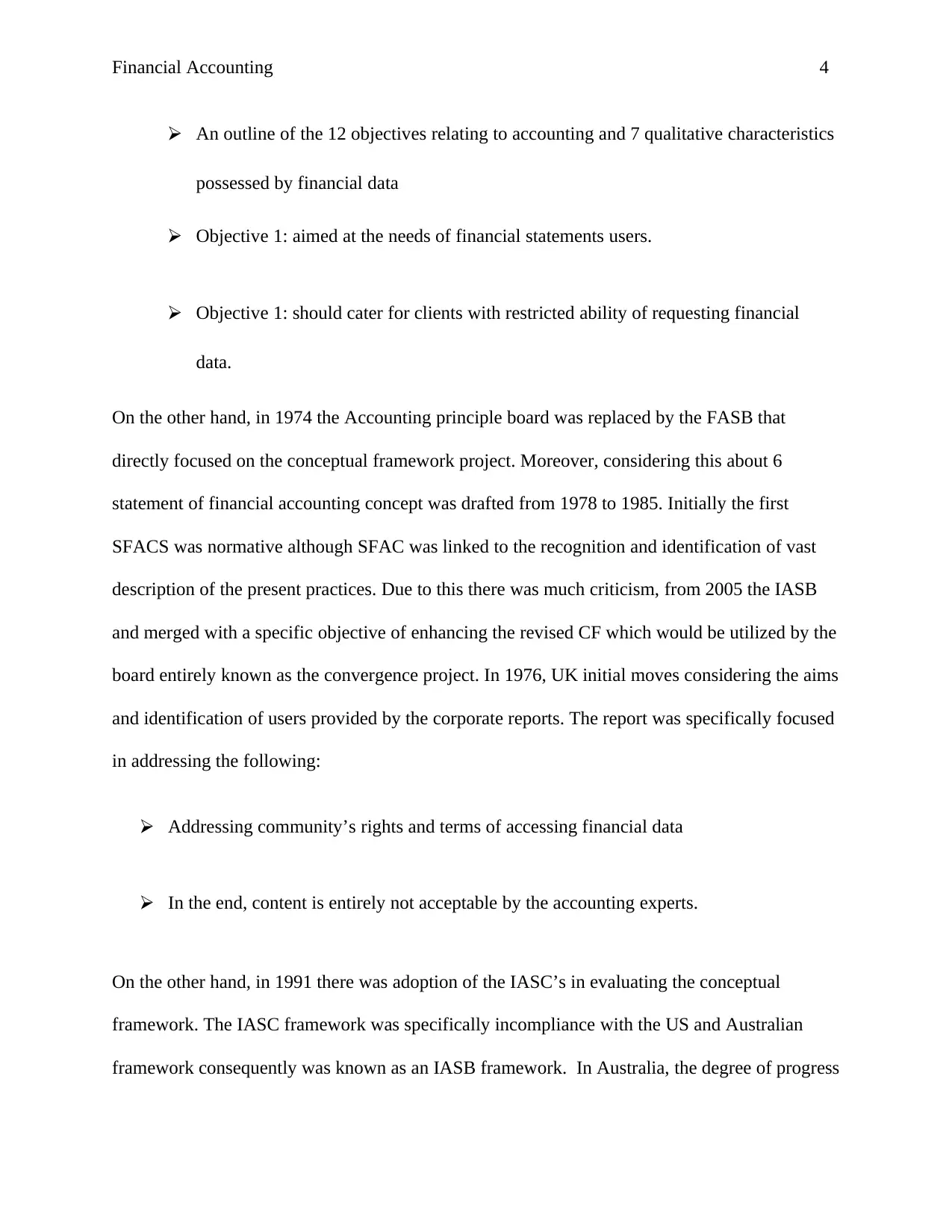
Financial Accounting 4
⮚ An outline of the 12 objectives relating to accounting and 7 qualitative characteristics
possessed by financial data
⮚ Objective 1: aimed at the needs of financial statements users.
⮚ Objective 1: should cater for clients with restricted ability of requesting financial
data.
On the other hand, in 1974 the Accounting principle board was replaced by the FASB that
directly focused on the conceptual framework project. Moreover, considering this about 6
statement of financial accounting concept was drafted from 1978 to 1985. Initially the first
SFACS was normative although SFAC was linked to the recognition and identification of vast
description of the present practices. Due to this there was much criticism, from 2005 the IASB
and merged with a specific objective of enhancing the revised CF which would be utilized by the
board entirely known as the convergence project. In 1976, UK initial moves considering the aims
and identification of users provided by the corporate reports. The report was specifically focused
in addressing the following:
⮚ Addressing community’s rights and terms of accessing financial data
⮚ In the end, content is entirely not acceptable by the accounting experts.
On the other hand, in 1991 there was adoption of the IASC’s in evaluating the conceptual
framework. The IASC framework was specifically incompliance with the US and Australian
framework consequently was known as an IASB framework. In Australia, the degree of progress
⮚ An outline of the 12 objectives relating to accounting and 7 qualitative characteristics
possessed by financial data
⮚ Objective 1: aimed at the needs of financial statements users.
⮚ Objective 1: should cater for clients with restricted ability of requesting financial
data.
On the other hand, in 1974 the Accounting principle board was replaced by the FASB that
directly focused on the conceptual framework project. Moreover, considering this about 6
statement of financial accounting concept was drafted from 1978 to 1985. Initially the first
SFACS was normative although SFAC was linked to the recognition and identification of vast
description of the present practices. Due to this there was much criticism, from 2005 the IASB
and merged with a specific objective of enhancing the revised CF which would be utilized by the
board entirely known as the convergence project. In 1976, UK initial moves considering the aims
and identification of users provided by the corporate reports. The report was specifically focused
in addressing the following:
⮚ Addressing community’s rights and terms of accessing financial data
⮚ In the end, content is entirely not acceptable by the accounting experts.
On the other hand, in 1991 there was adoption of the IASC’s in evaluating the conceptual
framework. The IASC framework was specifically incompliance with the US and Australian
framework consequently was known as an IASB framework. In Australia, the degree of progress
Paraphrase This Document
Need a fresh take? Get an instant paraphrase of this document with our AI Paraphraser
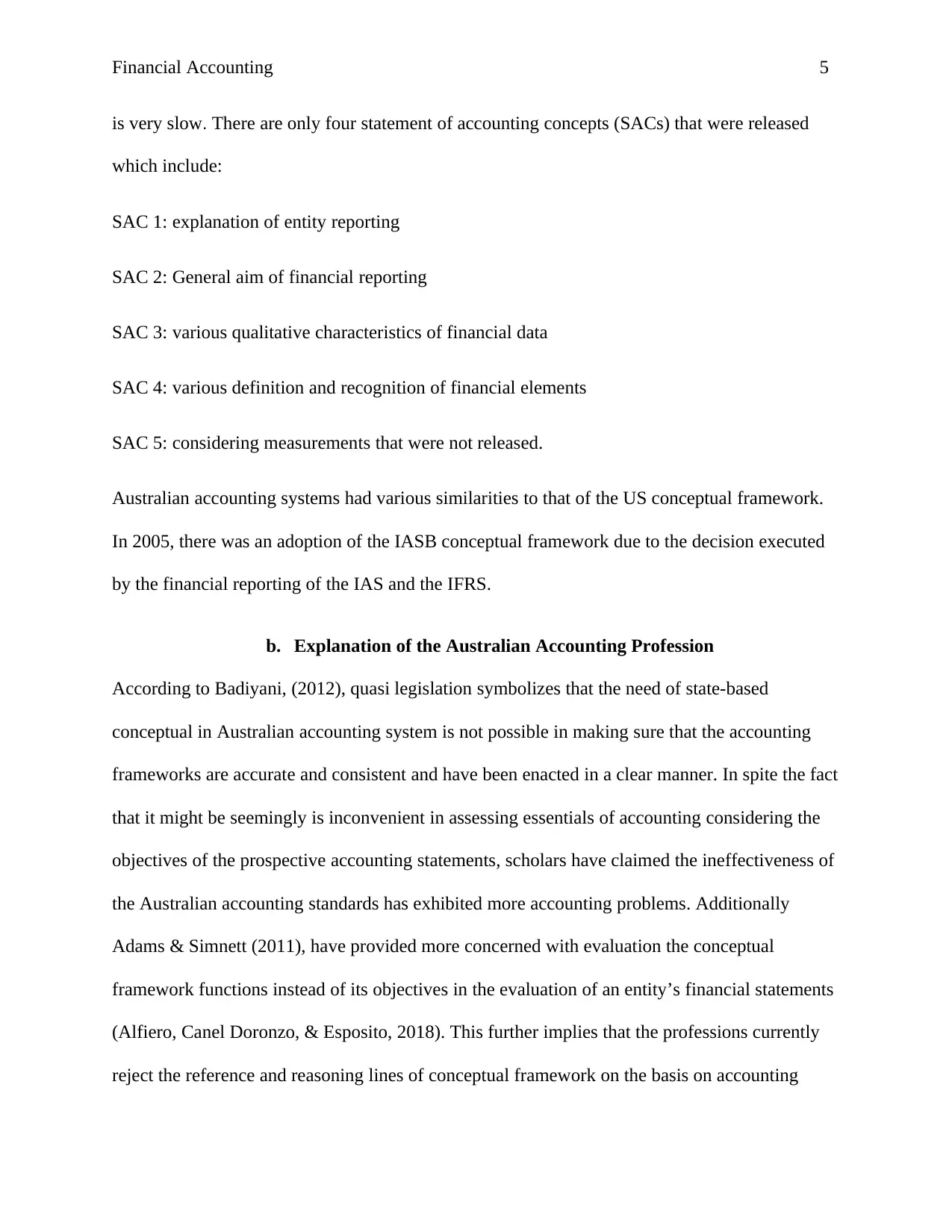
Financial Accounting 5
is very slow. There are only four statement of accounting concepts (SACs) that were released
which include:
SAC 1: explanation of entity reporting
SAC 2: General aim of financial reporting
SAC 3: various qualitative characteristics of financial data
SAC 4: various definition and recognition of financial elements
SAC 5: considering measurements that were not released.
Australian accounting systems had various similarities to that of the US conceptual framework.
In 2005, there was an adoption of the IASB conceptual framework due to the decision executed
by the financial reporting of the IAS and the IFRS.
b. Explanation of the Australian Accounting Profession
According to Badiyani, (2012), quasi legislation symbolizes that the need of state-based
conceptual in Australian accounting system is not possible in making sure that the accounting
frameworks are accurate and consistent and have been enacted in a clear manner. In spite the fact
that it might be seemingly is inconvenient in assessing essentials of accounting considering the
objectives of the prospective accounting statements, scholars have claimed the ineffectiveness of
the Australian accounting standards has exhibited more accounting problems. Additionally
Adams & Simnett (2011), have provided more concerned with evaluation the conceptual
framework functions instead of its objectives in the evaluation of an entity’s financial statements
(Alfiero, Canel Doronzo, & Esposito, 2018). This further implies that the professions currently
reject the reference and reasoning lines of conceptual framework on the basis on accounting
is very slow. There are only four statement of accounting concepts (SACs) that were released
which include:
SAC 1: explanation of entity reporting
SAC 2: General aim of financial reporting
SAC 3: various qualitative characteristics of financial data
SAC 4: various definition and recognition of financial elements
SAC 5: considering measurements that were not released.
Australian accounting systems had various similarities to that of the US conceptual framework.
In 2005, there was an adoption of the IASB conceptual framework due to the decision executed
by the financial reporting of the IAS and the IFRS.
b. Explanation of the Australian Accounting Profession
According to Badiyani, (2012), quasi legislation symbolizes that the need of state-based
conceptual in Australian accounting system is not possible in making sure that the accounting
frameworks are accurate and consistent and have been enacted in a clear manner. In spite the fact
that it might be seemingly is inconvenient in assessing essentials of accounting considering the
objectives of the prospective accounting statements, scholars have claimed the ineffectiveness of
the Australian accounting standards has exhibited more accounting problems. Additionally
Adams & Simnett (2011), have provided more concerned with evaluation the conceptual
framework functions instead of its objectives in the evaluation of an entity’s financial statements
(Alfiero, Canel Doronzo, & Esposito, 2018). This further implies that the professions currently
reject the reference and reasoning lines of conceptual framework on the basis on accounting
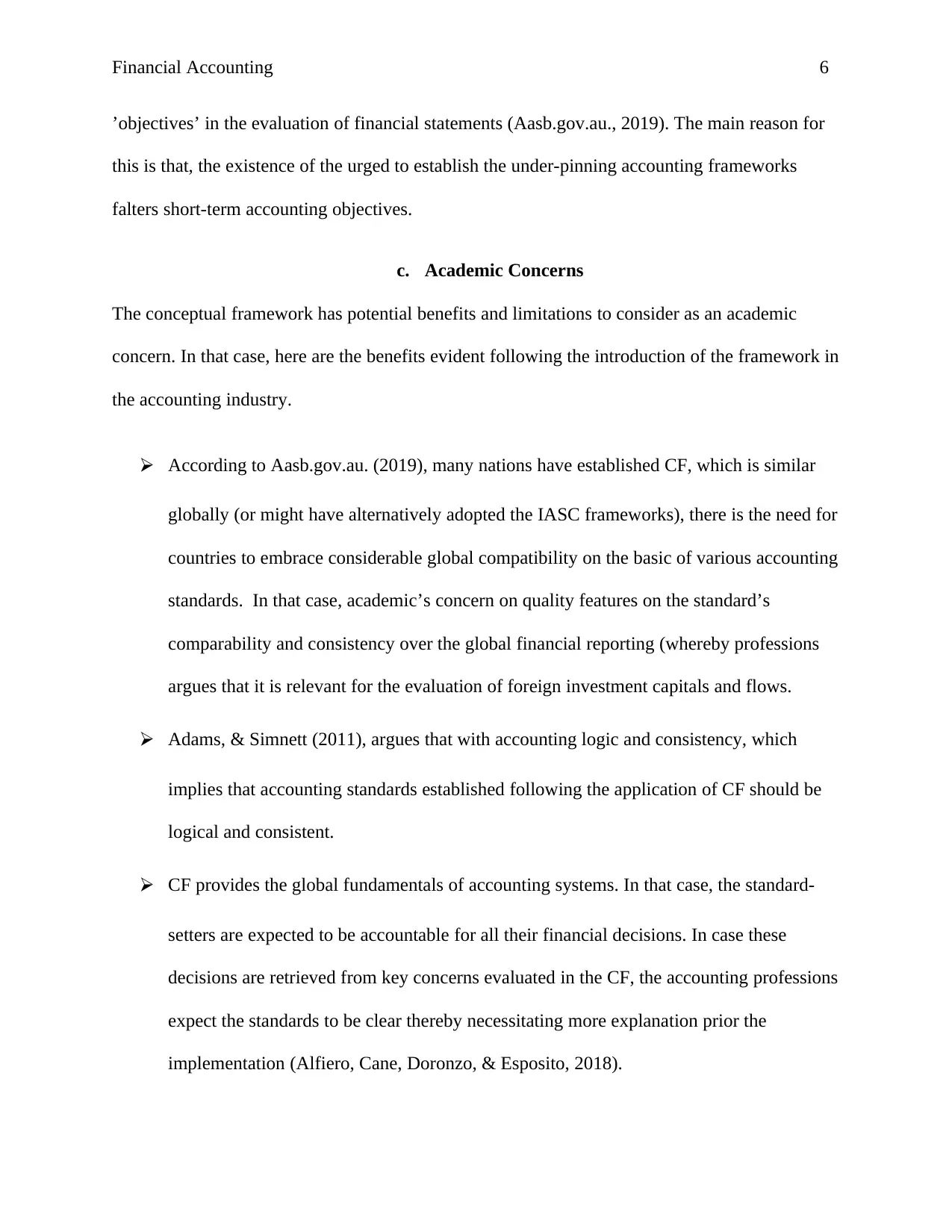
Financial Accounting 6
’objectives’ in the evaluation of financial statements (Aasb.gov.au., 2019). The main reason for
this is that, the existence of the urged to establish the under-pinning accounting frameworks
falters short-term accounting objectives.
c. Academic Concerns
The conceptual framework has potential benefits and limitations to consider as an academic
concern. In that case, here are the benefits evident following the introduction of the framework in
the accounting industry.
⮚ According to Aasb.gov.au. (2019), many nations have established CF, which is similar
globally (or might have alternatively adopted the IASC frameworks), there is the need for
countries to embrace considerable global compatibility on the basic of various accounting
standards. In that case, academic’s concern on quality features on the standard’s
comparability and consistency over the global financial reporting (whereby professions
argues that it is relevant for the evaluation of foreign investment capitals and flows.
⮚ Adams, & Simnett (2011), argues that with accounting logic and consistency, which
implies that accounting standards established following the application of CF should be
logical and consistent.
⮚ CF provides the global fundamentals of accounting systems. In that case, the standard-
setters are expected to be accountable for all their financial decisions. In case these
decisions are retrieved from key concerns evaluated in the CF, the accounting professions
expect the standards to be clear thereby necessitating more explanation prior the
implementation (Alfiero, Cane, Doronzo, & Esposito, 2018).
’objectives’ in the evaluation of financial statements (Aasb.gov.au., 2019). The main reason for
this is that, the existence of the urged to establish the under-pinning accounting frameworks
falters short-term accounting objectives.
c. Academic Concerns
The conceptual framework has potential benefits and limitations to consider as an academic
concern. In that case, here are the benefits evident following the introduction of the framework in
the accounting industry.
⮚ According to Aasb.gov.au. (2019), many nations have established CF, which is similar
globally (or might have alternatively adopted the IASC frameworks), there is the need for
countries to embrace considerable global compatibility on the basic of various accounting
standards. In that case, academic’s concern on quality features on the standard’s
comparability and consistency over the global financial reporting (whereby professions
argues that it is relevant for the evaluation of foreign investment capitals and flows.
⮚ Adams, & Simnett (2011), argues that with accounting logic and consistency, which
implies that accounting standards established following the application of CF should be
logical and consistent.
⮚ CF provides the global fundamentals of accounting systems. In that case, the standard-
setters are expected to be accountable for all their financial decisions. In case these
decisions are retrieved from key concerns evaluated in the CF, the accounting professions
expect the standards to be clear thereby necessitating more explanation prior the
implementation (Alfiero, Cane, Doronzo, & Esposito, 2018).
⊘ This is a preview!⊘
Do you want full access?
Subscribe today to unlock all pages.

Trusted by 1+ million students worldwide
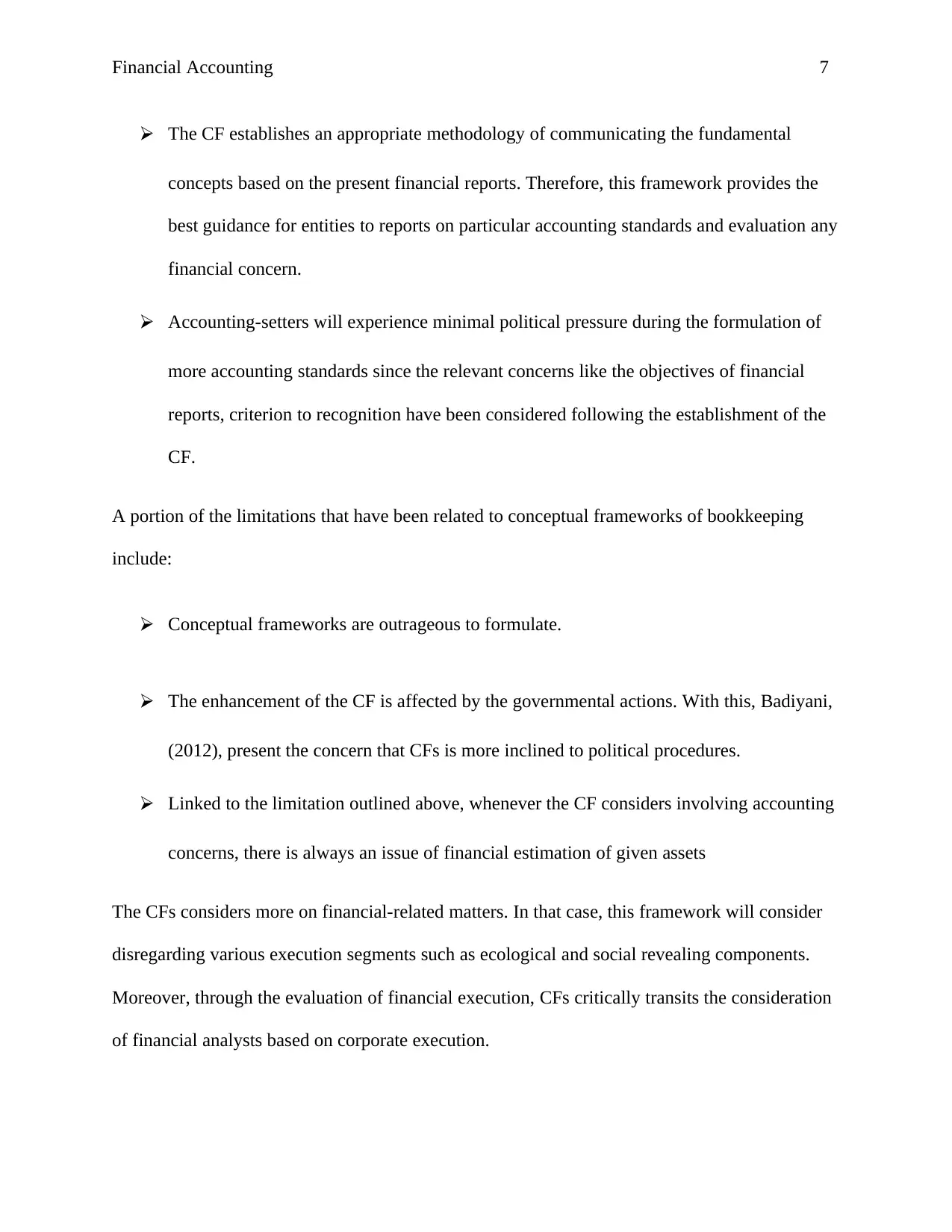
Financial Accounting 7
⮚ The CF establishes an appropriate methodology of communicating the fundamental
concepts based on the present financial reports. Therefore, this framework provides the
best guidance for entities to reports on particular accounting standards and evaluation any
financial concern.
⮚ Accounting-setters will experience minimal political pressure during the formulation of
more accounting standards since the relevant concerns like the objectives of financial
reports, criterion to recognition have been considered following the establishment of the
CF.
A portion of the limitations that have been related to conceptual frameworks of bookkeeping
include:
⮚ Conceptual frameworks are outrageous to formulate.
⮚ The enhancement of the CF is affected by the governmental actions. With this, Badiyani,
(2012), present the concern that CFs is more inclined to political procedures.
⮚ Linked to the limitation outlined above, whenever the CF considers involving accounting
concerns, there is always an issue of financial estimation of given assets
The CFs considers more on financial-related matters. In that case, this framework will consider
disregarding various execution segments such as ecological and social revealing components.
Moreover, through the evaluation of financial execution, CFs critically transits the consideration
of financial analysts based on corporate execution.
⮚ The CF establishes an appropriate methodology of communicating the fundamental
concepts based on the present financial reports. Therefore, this framework provides the
best guidance for entities to reports on particular accounting standards and evaluation any
financial concern.
⮚ Accounting-setters will experience minimal political pressure during the formulation of
more accounting standards since the relevant concerns like the objectives of financial
reports, criterion to recognition have been considered following the establishment of the
CF.
A portion of the limitations that have been related to conceptual frameworks of bookkeeping
include:
⮚ Conceptual frameworks are outrageous to formulate.
⮚ The enhancement of the CF is affected by the governmental actions. With this, Badiyani,
(2012), present the concern that CFs is more inclined to political procedures.
⮚ Linked to the limitation outlined above, whenever the CF considers involving accounting
concerns, there is always an issue of financial estimation of given assets
The CFs considers more on financial-related matters. In that case, this framework will consider
disregarding various execution segments such as ecological and social revealing components.
Moreover, through the evaluation of financial execution, CFs critically transits the consideration
of financial analysts based on corporate execution.
Paraphrase This Document
Need a fresh take? Get an instant paraphrase of this document with our AI Paraphraser
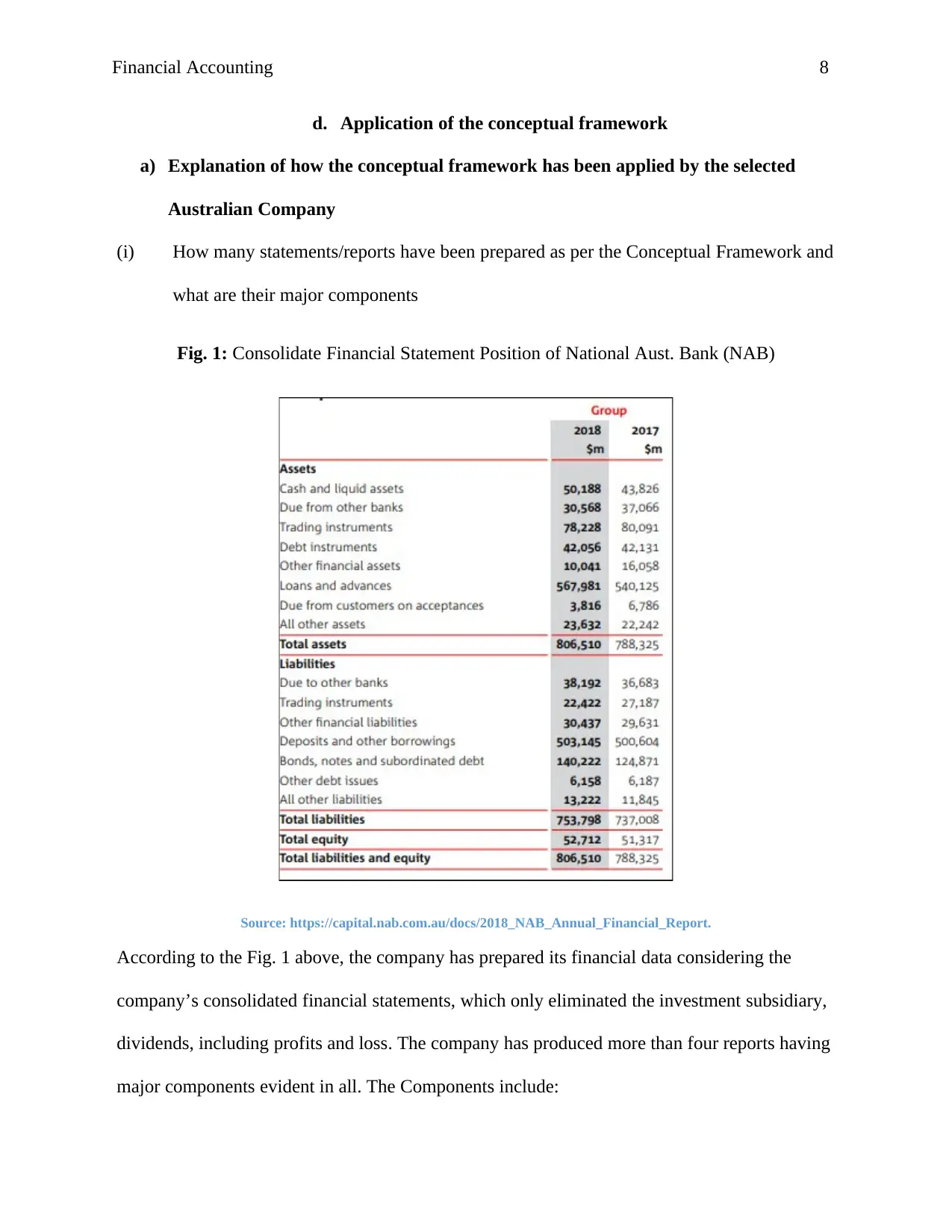
Financial Accounting 8
d. Application of the conceptual framework
a) Explanation of how the conceptual framework has been applied by the selected
Australian Company
(i) How many statements/reports have been prepared as per the Conceptual Framework and
what are their major components
Fig. 1: Consolidate Financial Statement Position of National Aust. Bank (NAB)
Source: https://capital.nab.com.au/docs/2018_NAB_Annual_Financial_Report.
According to the Fig. 1 above, the company has prepared its financial data considering the
company’s consolidated financial statements, which only eliminated the investment subsidiary,
dividends, including profits and loss. The company has produced more than four reports having
major components evident in all. The Components include:
d. Application of the conceptual framework
a) Explanation of how the conceptual framework has been applied by the selected
Australian Company
(i) How many statements/reports have been prepared as per the Conceptual Framework and
what are their major components
Fig. 1: Consolidate Financial Statement Position of National Aust. Bank (NAB)
Source: https://capital.nab.com.au/docs/2018_NAB_Annual_Financial_Report.
According to the Fig. 1 above, the company has prepared its financial data considering the
company’s consolidated financial statements, which only eliminated the investment subsidiary,
dividends, including profits and loss. The company has produced more than four reports having
major components evident in all. The Components include:
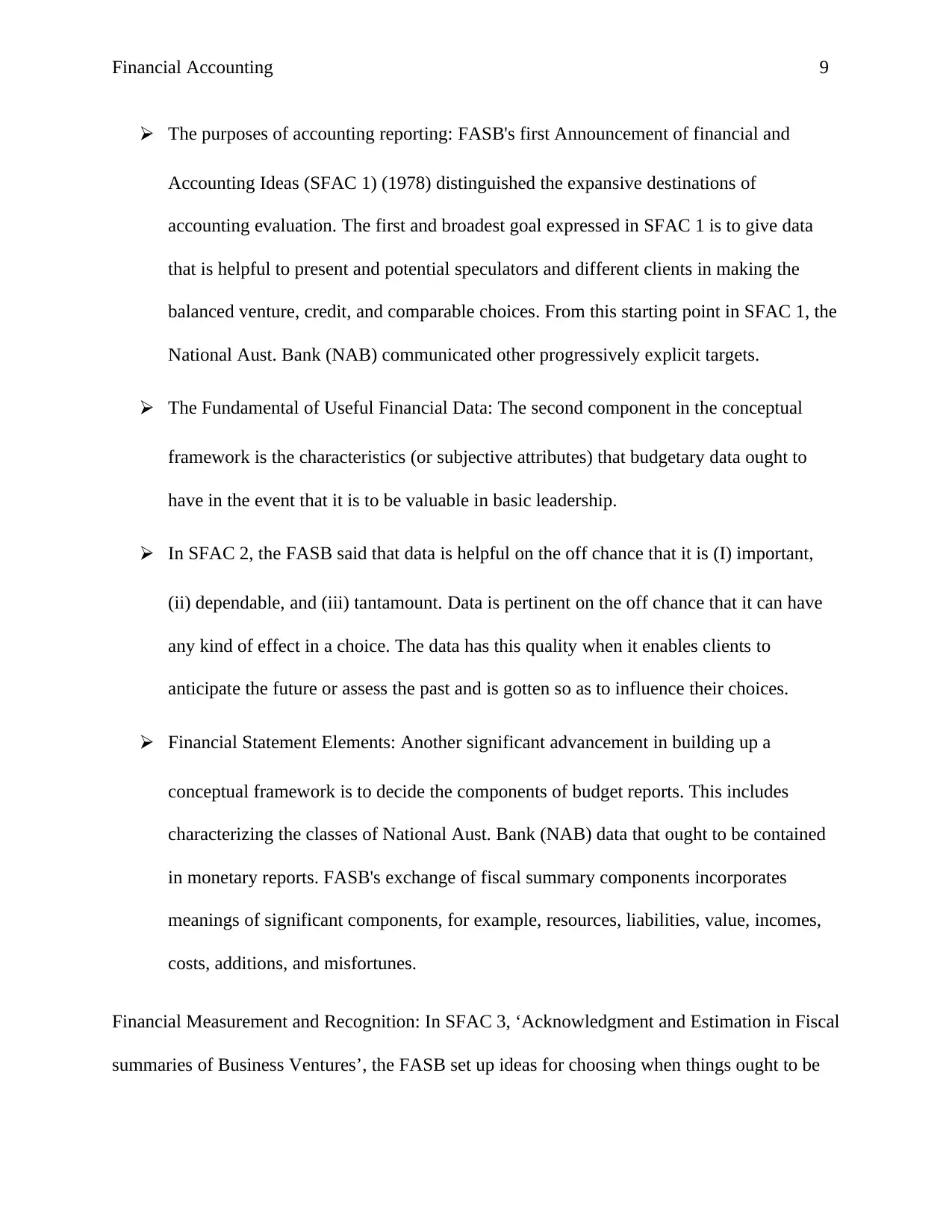
Financial Accounting 9
⮚ The purposes of accounting reporting: FASB's first Announcement of financial and
Accounting Ideas (SFAC 1) (1978) distinguished the expansive destinations of
accounting evaluation. The first and broadest goal expressed in SFAC 1 is to give data
that is helpful to present and potential speculators and different clients in making the
balanced venture, credit, and comparable choices. From this starting point in SFAC 1, the
National Aust. Bank (NAB) communicated other progressively explicit targets.
⮚ The Fundamental of Useful Financial Data: The second component in the conceptual
framework is the characteristics (or subjective attributes) that budgetary data ought to
have in the event that it is to be valuable in basic leadership.
⮚ In SFAC 2, the FASB said that data is helpful on the off chance that it is (I) important,
(ii) dependable, and (iii) tantamount. Data is pertinent on the off chance that it can have
any kind of effect in a choice. The data has this quality when it enables clients to
anticipate the future or assess the past and is gotten so as to influence their choices.
⮚ Financial Statement Elements: Another significant advancement in building up a
conceptual framework is to decide the components of budget reports. This includes
characterizing the classes of National Aust. Bank (NAB) data that ought to be contained
in monetary reports. FASB's exchange of fiscal summary components incorporates
meanings of significant components, for example, resources, liabilities, value, incomes,
costs, additions, and misfortunes.
Financial Measurement and Recognition: In SFAC 3, ‘Acknowledgment and Estimation in Fiscal
summaries of Business Ventures’, the FASB set up ideas for choosing when things ought to be
⮚ The purposes of accounting reporting: FASB's first Announcement of financial and
Accounting Ideas (SFAC 1) (1978) distinguished the expansive destinations of
accounting evaluation. The first and broadest goal expressed in SFAC 1 is to give data
that is helpful to present and potential speculators and different clients in making the
balanced venture, credit, and comparable choices. From this starting point in SFAC 1, the
National Aust. Bank (NAB) communicated other progressively explicit targets.
⮚ The Fundamental of Useful Financial Data: The second component in the conceptual
framework is the characteristics (or subjective attributes) that budgetary data ought to
have in the event that it is to be valuable in basic leadership.
⮚ In SFAC 2, the FASB said that data is helpful on the off chance that it is (I) important,
(ii) dependable, and (iii) tantamount. Data is pertinent on the off chance that it can have
any kind of effect in a choice. The data has this quality when it enables clients to
anticipate the future or assess the past and is gotten so as to influence their choices.
⮚ Financial Statement Elements: Another significant advancement in building up a
conceptual framework is to decide the components of budget reports. This includes
characterizing the classes of National Aust. Bank (NAB) data that ought to be contained
in monetary reports. FASB's exchange of fiscal summary components incorporates
meanings of significant components, for example, resources, liabilities, value, incomes,
costs, additions, and misfortunes.
Financial Measurement and Recognition: In SFAC 3, ‘Acknowledgment and Estimation in Fiscal
summaries of Business Ventures’, the FASB set up ideas for choosing when things ought to be
⊘ This is a preview!⊘
Do you want full access?
Subscribe today to unlock all pages.

Trusted by 1+ million students worldwide
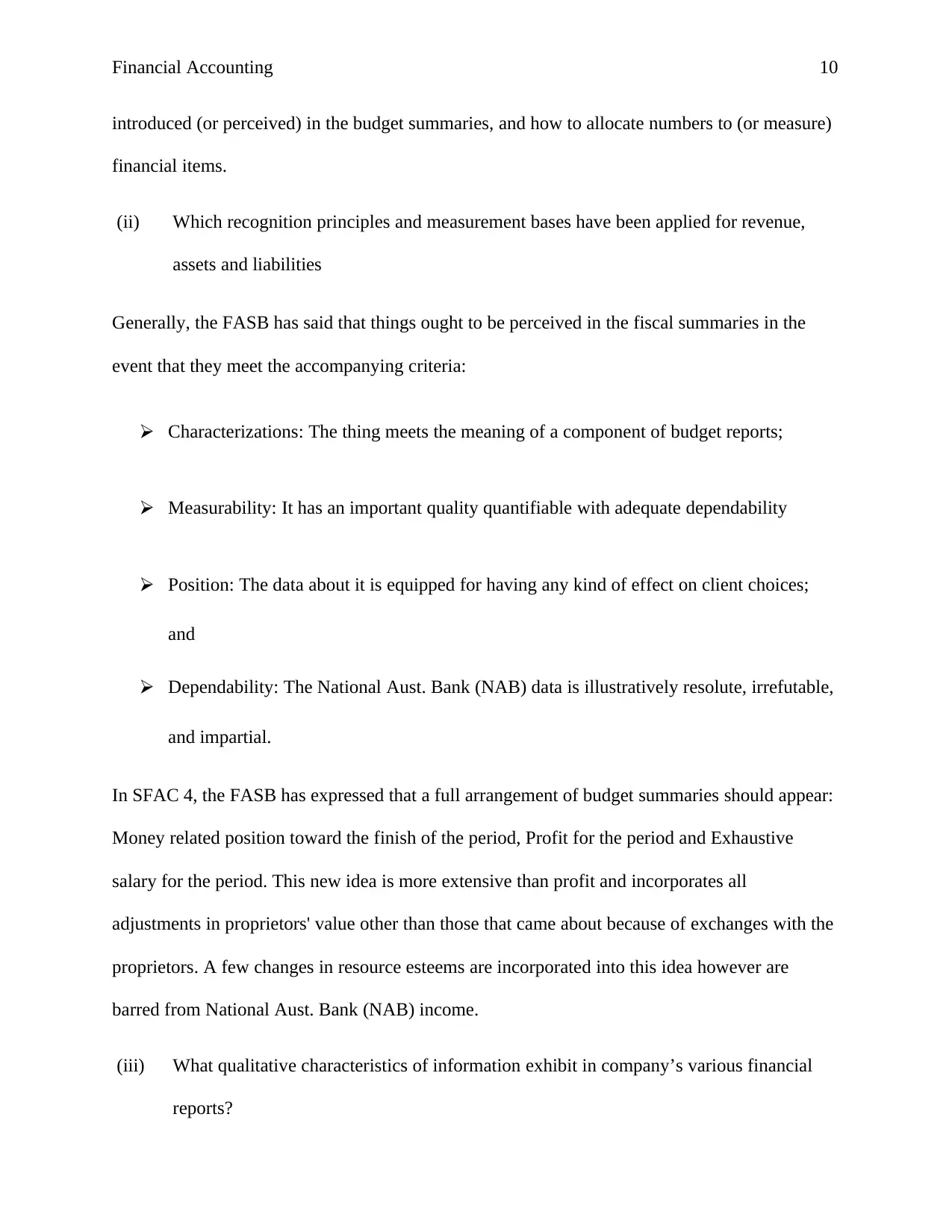
Financial Accounting 10
introduced (or perceived) in the budget summaries, and how to allocate numbers to (or measure)
financial items.
(ii) Which recognition principles and measurement bases have been applied for revenue,
assets and liabilities
Generally, the FASB has said that things ought to be perceived in the fiscal summaries in the
event that they meet the accompanying criteria:
⮚ Characterizations: The thing meets the meaning of a component of budget reports;
⮚ Measurability: It has an important quality quantifiable with adequate dependability
⮚ Position: The data about it is equipped for having any kind of effect on client choices;
and
⮚ Dependability: The National Aust. Bank (NAB) data is illustratively resolute, irrefutable,
and impartial.
In SFAC 4, the FASB has expressed that a full arrangement of budget summaries should appear:
Money related position toward the finish of the period, Profit for the period and Exhaustive
salary for the period. This new idea is more extensive than profit and incorporates all
adjustments in proprietors' value other than those that came about because of exchanges with the
proprietors. A few changes in resource esteems are incorporated into this idea however are
barred from National Aust. Bank (NAB) income.
(iii) What qualitative characteristics of information exhibit in company’s various financial
reports?
introduced (or perceived) in the budget summaries, and how to allocate numbers to (or measure)
financial items.
(ii) Which recognition principles and measurement bases have been applied for revenue,
assets and liabilities
Generally, the FASB has said that things ought to be perceived in the fiscal summaries in the
event that they meet the accompanying criteria:
⮚ Characterizations: The thing meets the meaning of a component of budget reports;
⮚ Measurability: It has an important quality quantifiable with adequate dependability
⮚ Position: The data about it is equipped for having any kind of effect on client choices;
and
⮚ Dependability: The National Aust. Bank (NAB) data is illustratively resolute, irrefutable,
and impartial.
In SFAC 4, the FASB has expressed that a full arrangement of budget summaries should appear:
Money related position toward the finish of the period, Profit for the period and Exhaustive
salary for the period. This new idea is more extensive than profit and incorporates all
adjustments in proprietors' value other than those that came about because of exchanges with the
proprietors. A few changes in resource esteems are incorporated into this idea however are
barred from National Aust. Bank (NAB) income.
(iii) What qualitative characteristics of information exhibit in company’s various financial
reports?
Paraphrase This Document
Need a fresh take? Get an instant paraphrase of this document with our AI Paraphraser
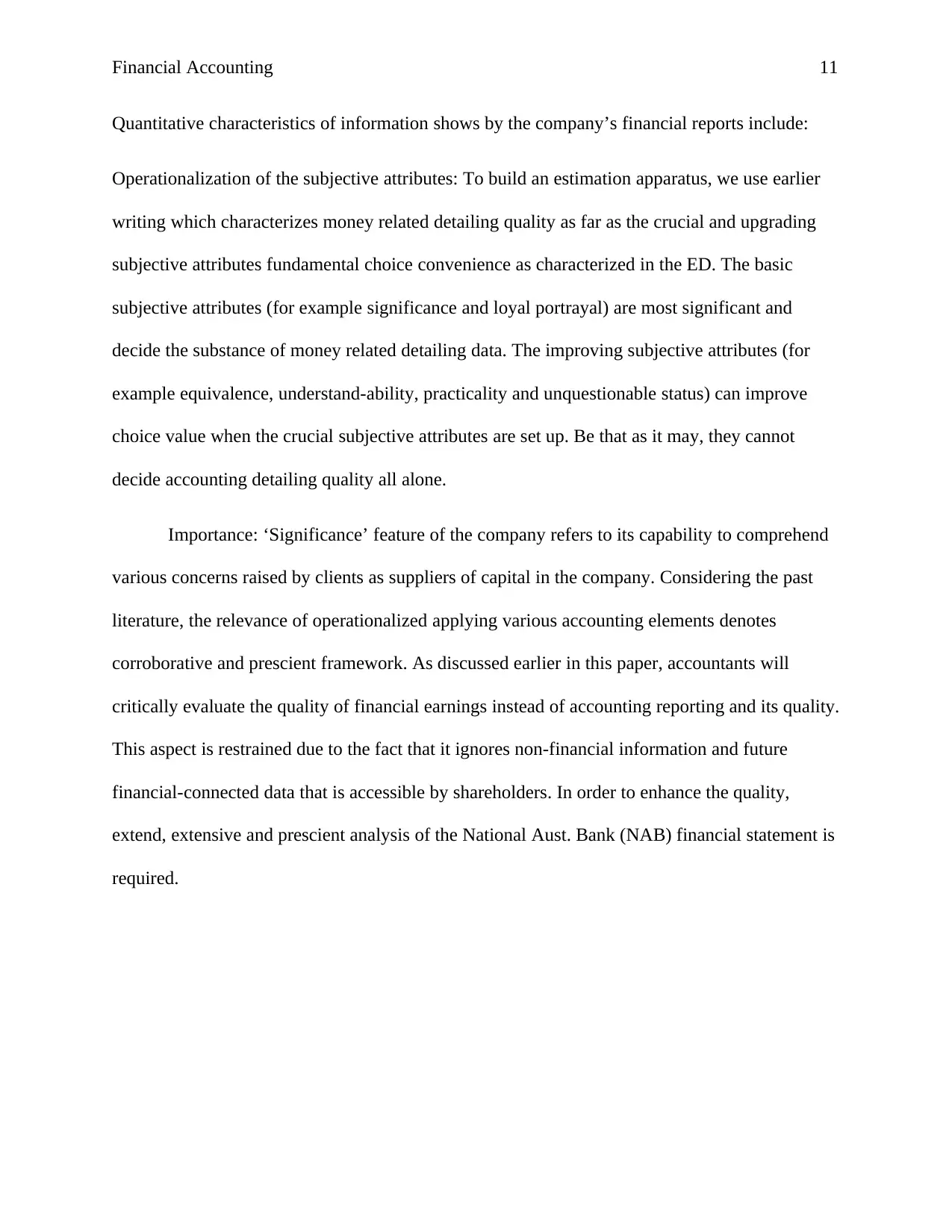
Financial Accounting 11
Quantitative characteristics of information shows by the company’s financial reports include:
Operationalization of the subjective attributes: To build an estimation apparatus, we use earlier
writing which characterizes money related detailing quality as far as the crucial and upgrading
subjective attributes fundamental choice convenience as characterized in the ED. The basic
subjective attributes (for example significance and loyal portrayal) are most significant and
decide the substance of money related detailing data. The improving subjective attributes (for
example equivalence, understand-ability, practicality and unquestionable status) can improve
choice value when the crucial subjective attributes are set up. Be that as it may, they cannot
decide accounting detailing quality all alone.
Importance: ‘Significance’ feature of the company refers to its capability to comprehend
various concerns raised by clients as suppliers of capital in the company. Considering the past
literature, the relevance of operationalized applying various accounting elements denotes
corroborative and prescient framework. As discussed earlier in this paper, accountants will
critically evaluate the quality of financial earnings instead of accounting reporting and its quality.
This aspect is restrained due to the fact that it ignores non-financial information and future
financial-connected data that is accessible by shareholders. In order to enhance the quality,
extend, extensive and prescient analysis of the National Aust. Bank (NAB) financial statement is
required.
Quantitative characteristics of information shows by the company’s financial reports include:
Operationalization of the subjective attributes: To build an estimation apparatus, we use earlier
writing which characterizes money related detailing quality as far as the crucial and upgrading
subjective attributes fundamental choice convenience as characterized in the ED. The basic
subjective attributes (for example significance and loyal portrayal) are most significant and
decide the substance of money related detailing data. The improving subjective attributes (for
example equivalence, understand-ability, practicality and unquestionable status) can improve
choice value when the crucial subjective attributes are set up. Be that as it may, they cannot
decide accounting detailing quality all alone.
Importance: ‘Significance’ feature of the company refers to its capability to comprehend
various concerns raised by clients as suppliers of capital in the company. Considering the past
literature, the relevance of operationalized applying various accounting elements denotes
corroborative and prescient framework. As discussed earlier in this paper, accountants will
critically evaluate the quality of financial earnings instead of accounting reporting and its quality.
This aspect is restrained due to the fact that it ignores non-financial information and future
financial-connected data that is accessible by shareholders. In order to enhance the quality,
extend, extensive and prescient analysis of the National Aust. Bank (NAB) financial statement is
required.
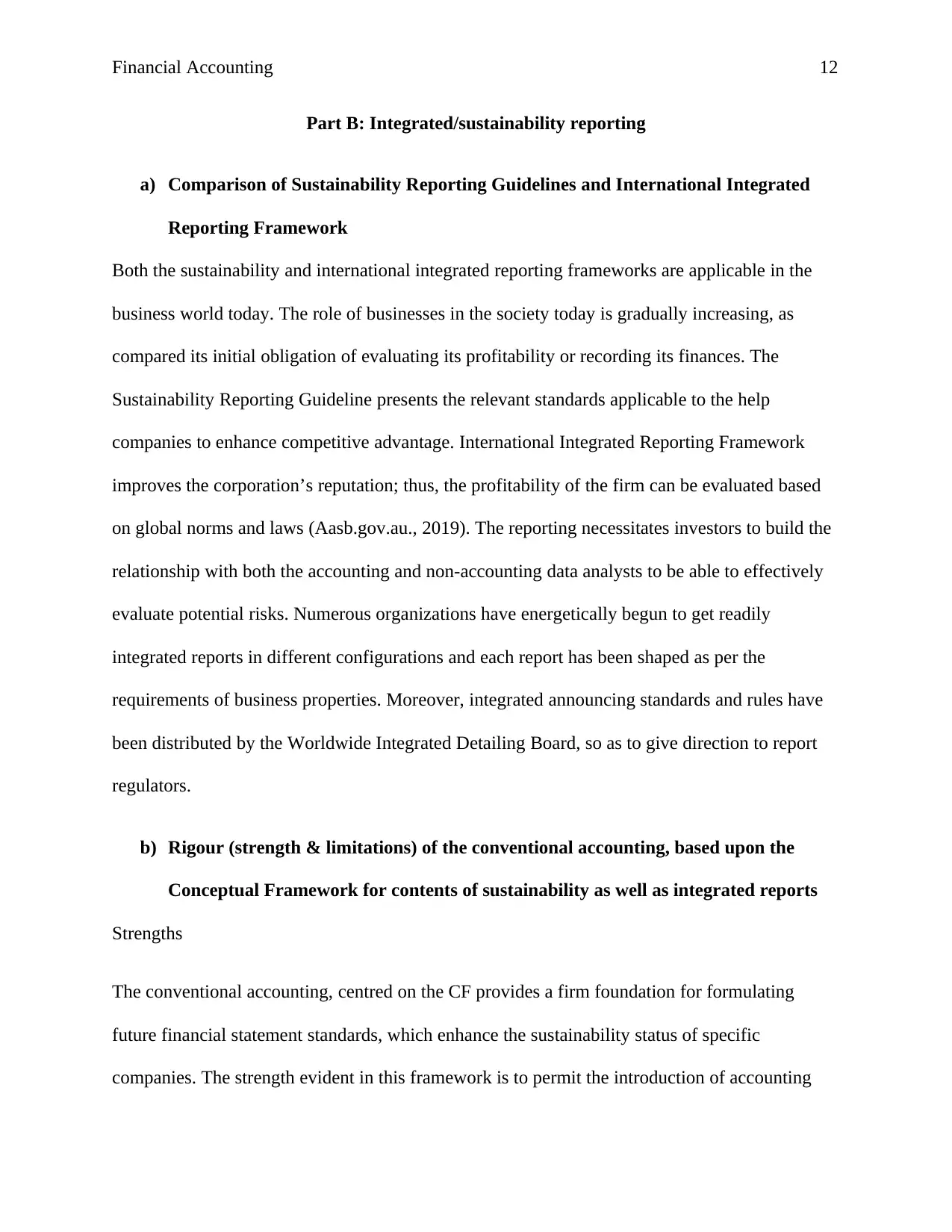
Financial Accounting 12
Part B: Integrated/sustainability reporting
a) Comparison of Sustainability Reporting Guidelines and International Integrated
Reporting Framework
Both the sustainability and international integrated reporting frameworks are applicable in the
business world today. The role of businesses in the society today is gradually increasing, as
compared its initial obligation of evaluating its profitability or recording its finances. The
Sustainability Reporting Guideline presents the relevant standards applicable to the help
companies to enhance competitive advantage. International Integrated Reporting Framework
improves the corporation’s reputation; thus, the profitability of the firm can be evaluated based
on global norms and laws (Aasb.gov.au., 2019). The reporting necessitates investors to build the
relationship with both the accounting and non-accounting data analysts to be able to effectively
evaluate potential risks. Numerous organizations have energetically begun to get readily
integrated reports in different configurations and each report has been shaped as per the
requirements of business properties. Moreover, integrated announcing standards and rules have
been distributed by the Worldwide Integrated Detailing Board, so as to give direction to report
regulators.
b) Rigour (strength & limitations) of the conventional accounting, based upon the
Conceptual Framework for contents of sustainability as well as integrated reports
Strengths
The conventional accounting, centred on the CF provides a firm foundation for formulating
future financial statement standards, which enhance the sustainability status of specific
companies. The strength evident in this framework is to permit the introduction of accounting
Part B: Integrated/sustainability reporting
a) Comparison of Sustainability Reporting Guidelines and International Integrated
Reporting Framework
Both the sustainability and international integrated reporting frameworks are applicable in the
business world today. The role of businesses in the society today is gradually increasing, as
compared its initial obligation of evaluating its profitability or recording its finances. The
Sustainability Reporting Guideline presents the relevant standards applicable to the help
companies to enhance competitive advantage. International Integrated Reporting Framework
improves the corporation’s reputation; thus, the profitability of the firm can be evaluated based
on global norms and laws (Aasb.gov.au., 2019). The reporting necessitates investors to build the
relationship with both the accounting and non-accounting data analysts to be able to effectively
evaluate potential risks. Numerous organizations have energetically begun to get readily
integrated reports in different configurations and each report has been shaped as per the
requirements of business properties. Moreover, integrated announcing standards and rules have
been distributed by the Worldwide Integrated Detailing Board, so as to give direction to report
regulators.
b) Rigour (strength & limitations) of the conventional accounting, based upon the
Conceptual Framework for contents of sustainability as well as integrated reports
Strengths
The conventional accounting, centred on the CF provides a firm foundation for formulating
future financial statement standards, which enhance the sustainability status of specific
companies. The strength evident in this framework is to permit the introduction of accounting
⊘ This is a preview!⊘
Do you want full access?
Subscribe today to unlock all pages.

Trusted by 1+ million students worldwide
1 out of 19
Related Documents
Your All-in-One AI-Powered Toolkit for Academic Success.
+13062052269
info@desklib.com
Available 24*7 on WhatsApp / Email
![[object Object]](/_next/static/media/star-bottom.7253800d.svg)
Unlock your academic potential
Copyright © 2020–2025 A2Z Services. All Rights Reserved. Developed and managed by ZUCOL.





